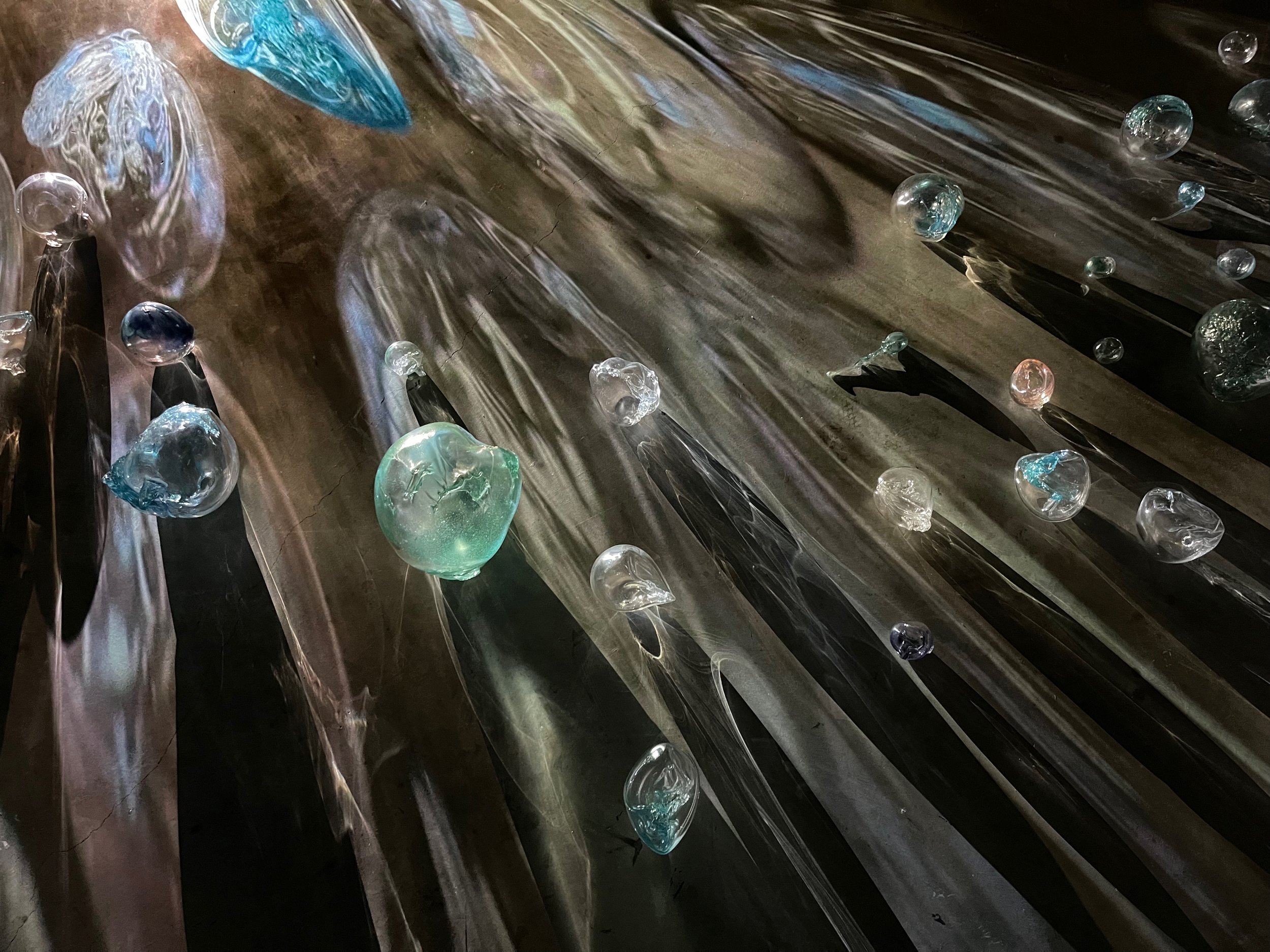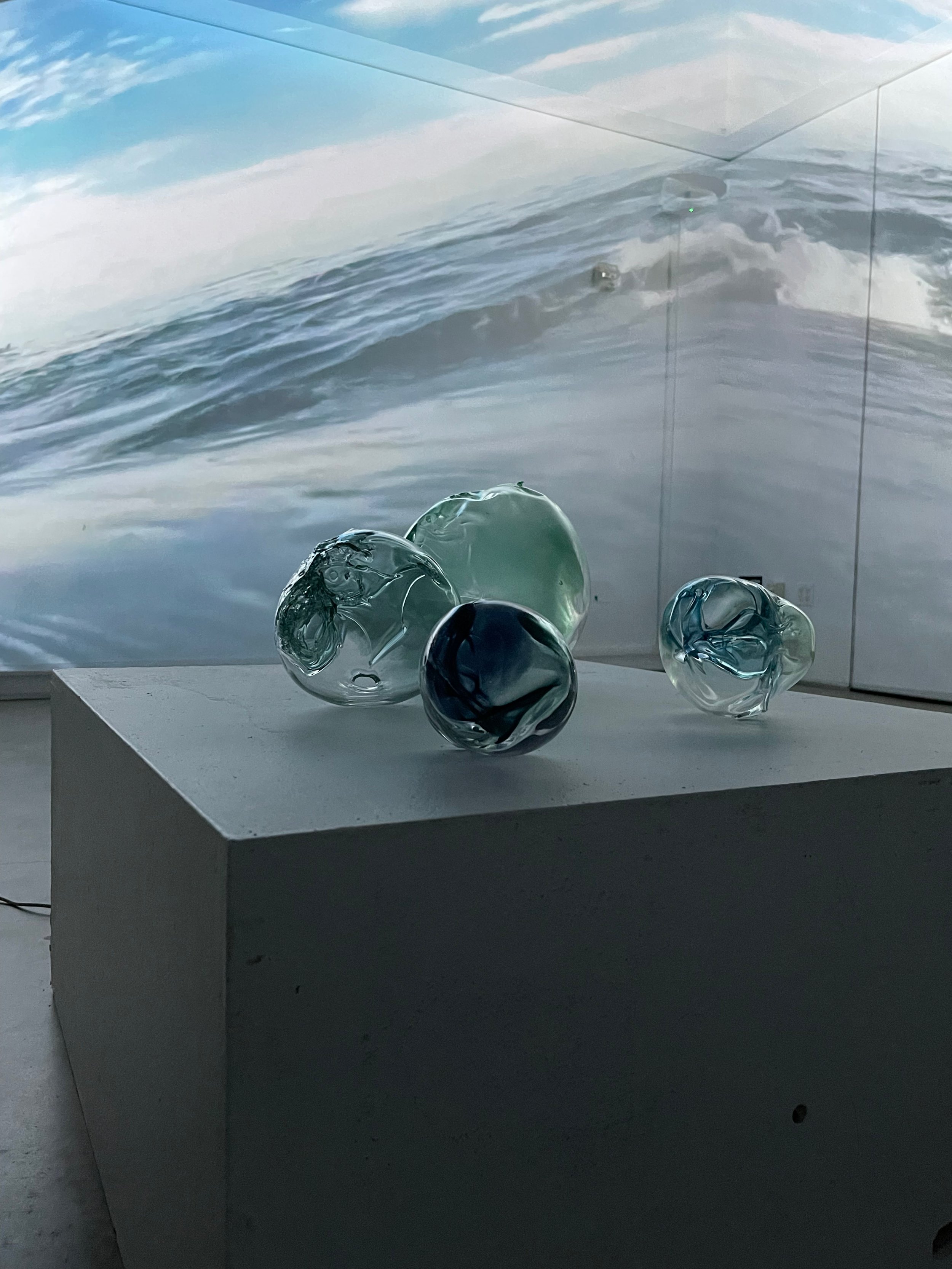How You Shimmer: Sound Portal for Whale Bubbles





How You Shimmer: Sound Portal for Whale Bubbles, (2024), sound, video, glass, bronze
A new installation How You Shimmer: Sound Portal for Whale Bubbles (2024) creates an immersive composition of underwater connection using sound, glass, bronze and projected moving light. Created as Resident Artist in the four year long research project Atmosphere of Sound: Sonic Art in Times of Climate Disruption at the UCLA Art|Sci Center, part of PST Art a Los Angeles wide Getty Initiative. January 10 - February 1, 2025, UCLA Art|Sci Gallery, California Nano Systems Institute, UCLA . Curated by Victoria Vesna and Anuradha Vikram
How do whales know fire? Do they know fire? Can they shape molten ideas, molten breath, that cools into meaning?
I’m trying to blow bubbles with molten glass, the heat of the warming planet and my own anger, dipping into it, moving and shaping it, into bubbles.
The whale feeds using bubbles as their tool, their breath forming a moving net. Bubbles and hot glass and underwater. Shimmer.
What if a whale breathed fire underwater? In their heating ocean, in their own anger, at our aggression and destruction.
So are the bubbles a lightness or do they carry dark? Are they floating, transcending? Can the bubbles carry the message, the imprint, through the rising motion?
This is a whales breath after all, controlled breath, like a musicians breath, coordinated. And what sound do those bubbles, those shimmers, carry? (There’s more to decoding the language of voice).
How do whales know fire? Do they know fire? Can they shape molten ideas, molten breath, that cools into meaning?
Atmosphere of Sound Exhibition Catalog
Catalogue Text
How You Shimmer: Sound Portal for Whale Bubbles, the result of research for Atmosphere of Sound, builds on my ideas of sonic materiality, sound portals, and the underwater sound world of whales. How might I place myself within ocean intelligences by listening expansively, and resisting hierarchies of knowledge? How might human technological extensions - scientific hydrophones, data collecting whale tags - offer opportunities to deepen our listening within global ecosystems? How can a multi sensorial approach to sound shift our perspectives on the ocean, re-orienting our awareness towards non-human intelligences and life-forms? A sound portal is the opportunity to explore such states of sonic reorientation.
The sounds of whale cultures are entwined with the history of human cultures. The frenzy of killing whales for profit destabilized ocean ecosystems for generations of whales (and humans). To explore these intergenerational connections, I have been working with scientists at the forefront of bioacoustic research into marine mammals. In Whale: Dundee I worked with recordings from Kate Stafford to create a harbor sound walk composed of voices of species under the arctic ice, those that in earlier generations were killed by the whaling industry. The sound walk Melt Me Into The Ocean was composed of sound recordings from Monterey Bay Aquarium Research Institute’s deep ocean hydrophone, and From a Whale’s Back created immersive video and sound projections from whale tags used by Ari Friedlaender’s lab to study the behaviors of whales. These connections to places, cultures, and interspecies relationships through sound has helped me recognize the importance of intergenerational oceans.
Rather than start from the whales sounds, in How You Shimmer I became curious to know more about their bubbles. Whales blow bubbles in a variety of circumstances, the well known is the collaborative ‘bubble-net feeding’ where humpbacks create a net of bubbles around a shoal of fish. Drawing from images created out of data from the whale tags, I sculpted the humpback’s traces during bubble net feeding, and cast them in bronze, three dimensional, heavy spiraled objects to be held and turned in ones hands. I carved outlines from the videos on artificial human bones and cast them in bronze, an inverted kind of ‘scrimshaw’, the nineteenth century whaler’s craft of carving on whale bones. I looked again at the videos of bubble net feeding from the viewpoint of a tag placed on a whale’s back, just behind the blowhole. Stopping the frames, I outlined the transforming shapes of the bubbles, noticing how they begin whole, form larger bubbles, distort, and gradually fragment. What communication might bubbles make? Sound and listening places us in a receptive attention towards these liminal zones of potential.
This made me interested to work with glass. The outline shapes of the whale’s bubbles that I traced from the videos became the guide for the glass making process and forms. Working together as a team, the timing of glass blowing is crucial, gathering from the furnace of molten glass, knowing when to heat, turn, cool, blow, shape. The concentrated way of being together, the focus and communication, is like playing music. Improvising music, letting the sounds lead, the hot glass also flows and behaves at the edge of control, a collaborator in the improvisation. The blown bubble collapses in its molten state, is blown again, collapses again and so on, folding it over and stretching it out, creating liquid-like seams and patterns on and within the glass. This process creates bubbles of all different sizes, colors, patterns and forms. These are the whale bubbles. We are slipping between cold ocean and molten glass. Slipping between states of being.
Which brings me back to the sounds themselves. The whale videos projected through the glass bubbles create reflections and refractions, distortions and spatial shimmers. These are also properties of certain sounds. I search and gather sounds that might relate to this shimmer bubble and molten transformation. I follow the sounds of glass, bronze, breath, harmonic resonances, spatial reverberations, perhaps even some voices. These lead me to create a space of contemplation that is a transformation of underwater worlds, a sound portal that transports us underwater while holding us simultaneously in our earth-bound experience. Perhaps a space for the whales to listen to us. The sound portal is a meditation of transience and the ephemeral, the breath of a whale transformed by heat into glass bubbles, sounds sparkling like that unseen vibrance - how you shimmer.
Blown glass ‘whale bubbles’, part of installation (2024)
Acknowledgements:
Thanks to lead glass blower Cassandra Straubing, Glass Faculty Head and Studio Coordinator San Jose State University, California
Whale tag video, sound and data, courtesy of Ari Friedlaender, Professor of Ocean Sciences, University of California Santa Cruz
Research and production supported by the Division of Research and Innovation at San José State University. The content is solely the responsibility of the author(s) and does not necessarily represent the official views of San José State University.
Research and production supported by the Arts Division, University of California Santa Cruz.


